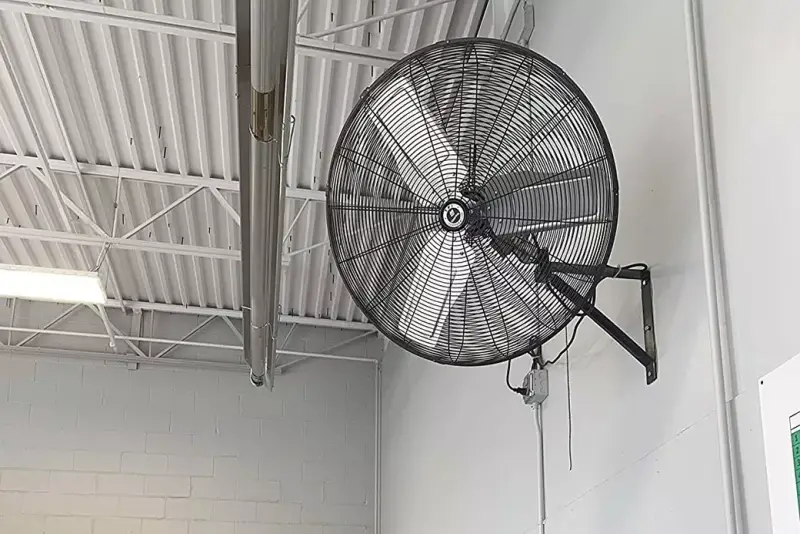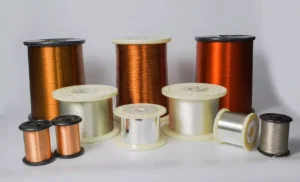Wall mount fans are a versatile and practical solution for keeping spaces comfortably cool without taking up floor space.
Whether you’re aiming to enhance air circulation in your cozy living room, maintain a fresh environment in your office, or ensure proper ventilation in a large workshop, wall mount fans come to the rescue with their space-saving design and effective performance.
Understanding the various aspects of wall mount fans—from their size and mounting requirements to their operational features and energy efficiency—can guide you in choosing the perfect model for your needs.
Let’s explore the key considerations and helpful tips to ensure you make an informed decision when selecting a wall mount fan, blending functionality, efficiency, and aesthetics seamlessly into your space.
Size And Mounting Space
When picking a wall-mount fan, start by looking at the space where you’ll put it.
You’ll need a fan that fits well without crowding the area.
Large fans are powerful and perfect for big rooms, but they need more wall space.
Make sure to measure your wall area and consider the fan’s size to ensure it fits comfortably.
Also, check the wall’s strength.
The fan will vibrate when it’s on, so your wall needs to be sturdy enough to hold the fan securely, avoiding any wobbling or potential falls.
Pick the right size, and you’ll have a fan that’s both effective and safe.
Airflow Capacity (CFM)
Airflow capacity, or CFM (Cubic Feet per Minute), is all about how much air your fan can move.
It’s key to picking the right fan, especially when you want to keep your air fresh.
If you know about ACH (Air Changes per Hour) and want your room’s air to be replaced a certain number of times per hour, you can calculate the CFM you need.
Here’s how: Multiply your room’s volume (area x height) by the ACH you desire. Then, divide by 60 to find the CFM.
For example, for a 450 sq. ft room with 8 ft ceilings:
- Calculate the volume: 450 sq. ft x 8 ft = 3,600 cu. ft.
- Multiply by the ACH (say, 6 times per hour): 3,600 cu. ft. x 6 ACH = 21,600.
- Divide by 60 to find the CFM: 21,600 / 60 = 360 CFM.
This means you’ll need a fan with a CFM of at least 360 to achieve 6 air changes per hour in that room.
If math’s not your thing, don’t worry – an ACH calculator can do the work for you!
Oscillation And Adjustable Tilt
Think of oscillation and adjustable tilt like the flexibility of a wall mount fan.
Oscillation lets the fan swing from side to side, spreading cool air all around the room.
It’s perfect when you want everyone to feel the breeze, not just one spot.
The adjustable tilt is like nodding the fan’s head up or down.
This lets you aim the air exactly where you need it, whether that’s down low on a hot day or up high to push warm air down in cooler weather.
Together, these features make sure your fan covers more area and keeps everyone comfy, no matter where they are in the room.
Speed Settings And Controls
Speed settings in a wall-mount fan are like having a thermostat for your breeze.
More speed options mean you can fine-tune the airflow to feel just right.
On a scorching day, crank it up to high and feel the strong gusts cool you down.
If it’s just a bit warm, a gentle, low-speed breeze might be all you need.
Controls make your life easier, too.
Some fans have remote controls or panels on the wall, so you don’t even have to get up to change the settings.
It’s all about making your space as comfortable as possible with the push of a button or the flip of a switch.
Build Quality And Durability
When you pick a wall mount fan, think about build quality and durability like choosing a sturdy backpack for a long hike.
You want something that can handle the journey without falling apart.
A fan with strong metal or hard plastic blades and a solid motor lasts longer and usually runs quieter.
If your fan’s going outdoors or in a busy workshop, it’s even more important to choose one that’s tough enough for the job.
It might cost a bit more upfront, but a well-built fan saves you from repairs or replacements down the line.
It’s all about getting a fan that’s ready to stand the test of time and keep you cool along the way.
Noise Level
The noise level of a wall-mount fan is like the volume of your background music—it shouldn’t be so loud that it’s all you can hear.
Fans are measured in decibels (dB), and a lower dB means a quieter fan.
In a place like your bedroom or office, where you need peace and quiet, choosing a fan with a low noise level is crucial.
Even in livelier areas, a fan that hums softly is better than one that roars.
Before you buy, check the fan’s noise rating or, if possible, listen to it in action.
A quiet fan blends into the background, keeping you cool without making itself heard.
Energy Efficiency
Energy efficiency in a wall-mount fan is like getting the best gas mileage in your car – it keeps you moving without costing a fortune.
Fans that use less electricity lighten the load on your bills and are kinder to the environment.
Look for features like energy-saving motors or programmable timers that turn the fan off when it’s not needed.
Some fans even come with energy-efficient settings, letting you balance cooling and power use.
Choosing an energy-efficient fan means you’ll stay cool and comfortable without the stress of high electricity costs, making it a smart choice for both your wallet and the planet.
Safety Features
Safety features in a wall mount fan are like the guardrails on a bridge — they ensure everything stays secure and safe.
Look for fans with sturdy grills that keep fingers and objects away from the blades.
It’s also smart to choose a fan with a reliable mounting system to prevent wobbles or falls.
Overheating protection is another key feature, as it helps prevent the motor from getting too hot and causing problems.
If you have kids or pets around, these safety aspects become even more critical.
A fan with strong safety features gives you peace of mind, knowing that while it keeps you cool, it’s also built to protect your home and family.
Aesthetics And Design
Aesthetics and design in a wall mount fan are like the icing on a cake — they make everything more appealing.
A fan isn’t just a functional appliance; it’s part of your room’s look.
Modern fans come in various styles and colors, so you can choose one that complements your space.
Whether you prefer a sleek, contemporary design or a classic, vintage look, there’s a fan that matches your taste.
The right fan should blend in seamlessly with your decor, becoming a stylish addition rather than an eyesore.
Remember, a fan that looks good and works well can elevate your space, making it comfortable and chic.
Warranty And Customer Support
Warranty and customer support for a wall mount fan are like having a safety net under a tightrope walker.
They give you confidence in your purchase.
A solid warranty means the manufacturer stands behind their product.
Look for a fan with a lengthy warranty period that covers both parts and labor.
This can save you from unexpected repair costs if something goes wrong.
Good customer support is just as crucial.
You want a responsive team that’s ready to help with installation questions, troubleshooting, or warranty claims.
Reliable support and a strong warranty can turn a good fan into a great investment, offering peace of mind and ensuring your comfort for years to come.
FAQ
Q1: Can wall-mount fans be used outdoors?
A1: Yes, some wall-mount fans are designed for outdoor use. Look for models with weather-resistant materials and construction. Ensure the fan is rated for outdoor use to withstand elements like humidity and varying temperatures.
Q2: How difficult is it to install a wall-mount fan?
A2: Installation complexity varies by model. Most residential wall mount fans come with mounting kits and straightforward instructions. However, for larger, industrial models or for optimal placement, professional installation might be recommended.
Q3: Are wall mount fans safe to use around children and pets?
A3: Yes, when properly installed and used with caution. Choose a fan with a protective grill and ensure it’s securely mounted out of reach. Always supervise children and pets around operating fans.
Q4: How do I clean and maintain my wall mount fan?
A4: Regular cleaning involves wiping the exterior with a soft, damp cloth and vacuuming the grill to remove dust. Always unplug the fan before cleaning. Check the manufacturer’s instructions for specific maintenance guidelines.
Q5: Do wall-mount fans consume a lot of electricity?
A5: It depends on the model and usage. Energy-efficient models are available that consume less power. Using fans with programmable timers or adjustable settings can also help reduce electricity usage.
Q6: Can the airflow direction be adjusted on all wall-mount fans?
A6: Many fans offer adjustable tilt or oscillation features, allowing you to direct airflow. However, the range of adjustability can vary between models, so it’s best to check the specific features of the fan you’re considering.
Q7: How do I choose the right size fan for my room?
A7: Consider the size of the space and the fan’s CFM rating. A larger room or space with high ceilings may require a fan with a higher CFM for effective air circulation.
Q8: Are there quiet models of wall-mount fans for noise-sensitive areas?
A8: Yes, there are fans designed to operate quietly, ideal for environments like bedrooms or offices. Look for fans with noise-reduction features and check the decibel (dB) rating.
Q9: Can wall-mount fans replace air conditioning?
A9: While fans can significantly improve air circulation and create a cooling effect, they don’t lower the actual temperature like an air conditioning unit. However, using fans in conjunction with AC can enhance cooling and improve energy efficiency.
Q10: Is it possible to repair a wall mount fan if it stops working?
A10: Often, yes. Simple issues like loose connections or worn-out switches can be fixed. However, for more complex problems or warranty-covered repairs, it’s best to consult a professional or the manufacturer.







